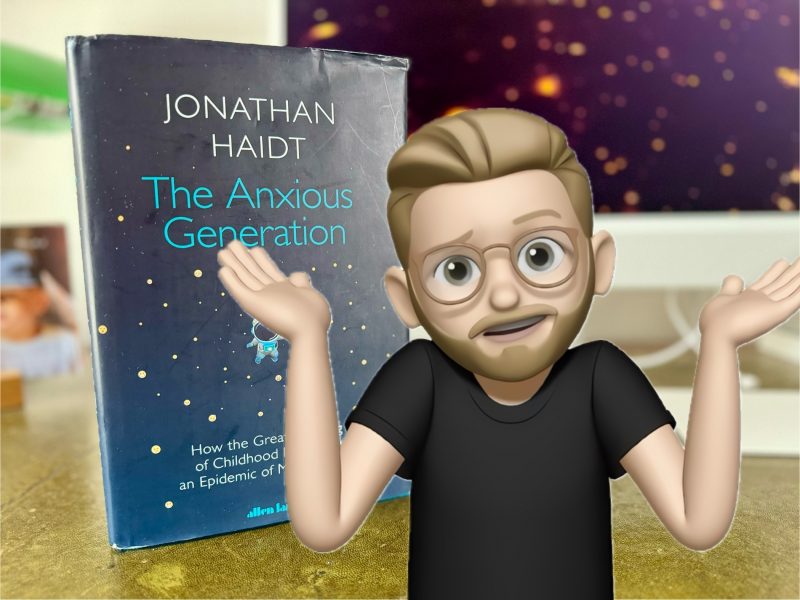In his new book “The Anxious Generation“, Jonathan Haidt posits that the well-being of young people, and especially that of young girls, has decreased dramatically across the last fifteen years. The two major reasons for this decline, according to Haidt, are increased social media use and decreased play and interactions unsupervised by adults. In a nutshell, kids would be under-protected online and over-protected offline. Haidt goes on to suggest several solutions, such as smartphone bans in schools, increasing the age of social media use to 16, actually enforcing age limits, or increasing offline unregulated interactions (he co-started “Let Grow“).
The book was an instant bestseller. It includes some strong claims, and it has received much media attention. The general public’s echo was largely positive, and the scholarly reception reserved (for critical reviews, see Fried; guardian; Lebedíková, New York Times; Odgers; Seawall; vox).
So is Haidt right? Are we dealing with an anxious generation sitting alone at home being addicted to their social media feeds? Or is it rather that we’re reading the expressed fears of an over-concerned father-of-two who simply wants so sell some books?
In this blog post, I provide my review of The Anxious Generation. Let’s begin with what I believe are weak arguments often levelled against Haidt.
The it’s simple technophobia-fallacy
Haidt is often criticized for being yet another technophobe. First books, then radio, rock music, video games, Internet, Smartphones, now Social Media.

But let’s be fair: Haidt’s criticism levelled toward social media is not all encompassing. It’s nuanced.
Haidt is not criticizing social media per se. Instead, he is focusing on (a) social media platforms (or social networking sites; e.g. Instagram, TikTok, or Facebook). He’s not criticizing instant messengers or video clients (such as WhatsApp, Facetime or Zoom). He is critical of one-to-many or many-to-one communication, where users predominantly broadcast the best sides of their lives to masses of mostly unbeknownst others. Also, he’s particularly critical of youngsters having user accounts with personalized content, but not so much of generally watching videos on TikTok or YouTube.
He’s limiting his critique to young people, so mostly everyone younger than 18 years. He does acknowledge that social media platforms have many benefits, especially when it comes to information management or reputation building. However, according to Haidt, these benefits are mostly irrelevant for younger people, especially 10 to 14 year olds, who would mostly use social media for entertainment. As the cortical structures to inhibit behavior are not fully developed yet, it’d harder for young people to stop consuming too much of a good thing.
He’s making the case that effects are worse for girls than boys. Boys also suffer, but not that much; they rather play video games, which have more balanced effects (apart from 5-10 % who would become addicted).
He’s also making the nuanced point that social media have changed and are becoming increasingly problematic. He mentions the introduction of the endless scrolling function, push notifications, the increased implementation of enticing video content, and ever improved personalization via better algorithms. Kid’s TikTok of today is not our MySpace of yesterday.
Haidt is not against scholars discussing research on bluesky, but against young people spending 40 hours per week on mostly video content pushing problematic narratives.
The induction fallacy
Relatedly, it is often argued that all prior technophobias turned out to be wrong, so why should it be different this time? Books weren’t harmful, the radio wasn’t, rock music wasn’t, and social media is now just yet another iteration of the same technology panic. My take is: Perhaps it’s not that easy.
Yes, it’s crucial to know that with each new technological trend there’ll automatically be associated concerns and accompanying doomsayers. I love and regularly cite Amy Orben’s Sisyphus paper, in which she eloquently outlines the problem. We need to know that this reflex exists, and that there’s a market for books peddling concerns.
However, first, it’s not entirely clear if indeed all prior prophecies turned out to be wrong and were net neutrals for society (looking at you, television). Second, even if all prior panics were indeed unjustified, this just doesn’t mean that all new ones automatically will be so, too. It’s Hume’s age old induction fallacy. (Let’s have a brief moment of silence for the goose who had no reason to doubt the farmer until one day it was slaughtered.)
Of course, this argument could also be made for the most outlandish conspiracy theory. However, considering the empirical data and theoretical analyses presented, Haidt’s thesis possesses sufficient credibility to warrant serious consideration. Today’s social media isn’t reading books, watching tv, or commenting on each other’s Facebook walls — it’s so much more enticing. After all, young people have never spent, on average, 40 hours per week reading books.
It’s important to know that technology panics exist, that there’s a market to sell books – but the argument is not as strong as some believe.
The correlation isn’t causation over-interpretation
Haidt is criticized because he shows downward facing mental health trends together with upward shooting social media use statistics, and as we all know quite well correlation doesn’t equal causation. Granted, Haidt produces additional studies explicitly analyzing potential causations, but that’s not what I want to get at here.
Many of us know the graphs showing that Nicolas Cage’s appearances in movies perfectly predict voting behavior. Yes, correlation is not a sufficient condition for causation. However, correlation not being sufficient for causation is also not a sufficient condition for assuming no causation.
Let’s not throw out the baby with the bathwater. It’s not that we observe correlations everywhere. Although there is something such as crud, the correlations between social media use and depression – which are estimated to be somewhere around r = .10 and .20 – are too large for that. Finding such correlations isn’t as common as finding no correlations. Correlations are noteworthy, and they warrant further inspection. We might not know about the direction of the effect. Perhaps the effects vanish after controlling for all relevant confounders, but perhaps they also don’t.
To illustrate, in a recent study (still unpublished) we asked more than six thousand Austrian middle and high schoolers regarding their social media use and their well-being. The average correlation was r = -.25. Even after controlling for many potential confounders (are they living with their parents, do they have an own room, an Austrian passport, are their parents Austrian, Gender, Age, Grade, Weight, Height, income/pocket money, number of siblings) the correlation was r = -.18. A nothing-burger looks different.
Again, I’m just saying that the argument is not as strong as some might believe.
The delegitimizing expertise fallacy
Haidt is sometimes derided for not being a developmental, media, or communication scholar himself. Indeed, he’s a social psychologist. So it is implied he’s lacking the authority and that we shouldn’t take him seriously.
I’m not impressed. This is a weak criticism. Especially as scholars, we should always aim to focus on the actual content, to address the core arguments, and to see if they hold. It’s a defining feature of science not to care about who said something, but about what that person said.
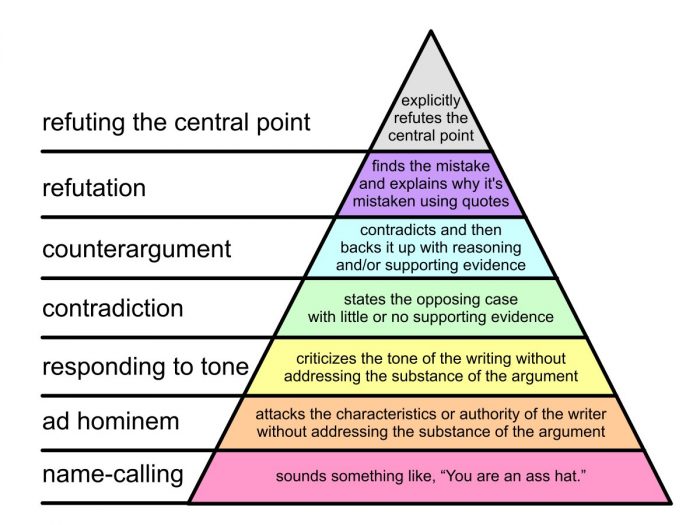
And, granted, Social Psychology and Media Psychology/Communication aren’t that different. Mostly same methods, similar theories, same subjects. Media Psychology isn’t rocket science, and it’s not that a theologian would be discussing microbiology, where the expertise and background argument would have more clout.
Yes, you need to do your homework, read dozens of studies, engage with various viewpoints. But it’s not that this would be impossible for a social psychologist to achieve. Sometimes, an outsider perspective from an adjacent field can even be beneficial.
So let’s finally do that, let’s look at the central points of the book. Are they correct?
Is there a mental health crisis?
Regarding the decrease in teen well-being and the increase in depression, Haidt produces several graphs, showing how various measures of mental health are deteriorating. They mainly outline the situation for the U.S. and the Anglosphere, but also for some other countries.
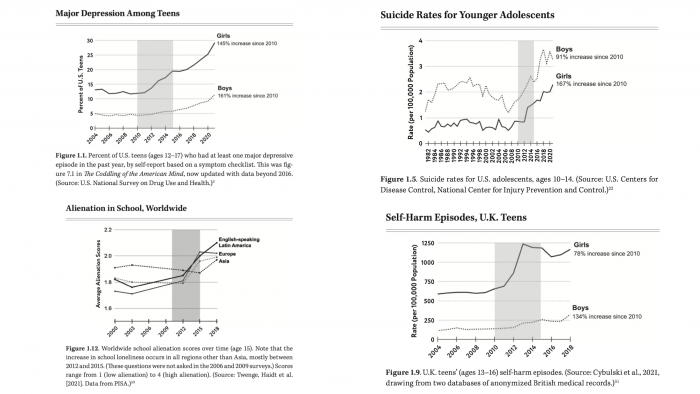
The data are quite striking. But note that some of the presented data can be second-guessed. For example, Haidt shows that self-harm behaviors have increased, when this might be due to a change in the coding procedure. Likewise, other agencies for the U.S. do not report increasing suicide rates. The case is likely not that strong as reported.
In a blog post a couple of years ago I asked myself this question, too. I used data from the European Social Survey, which includes more than 450.000 people from Europe – quite impressive. One question is always asked: How happy are you with your life? I updated the analyses for this blog post, now including data from 2020, with respondents aged 15 to 20 (n = 32.096). And what do the results show?
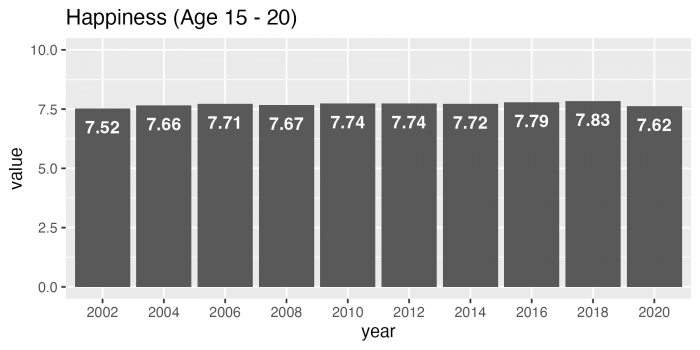
No decline whatsoever.
In Europe, when it comes to well-being, the perhaps best data sources says there’s no decline.
However, presence of well-being does not mean absence of ill-being. When it comes to depression, I recently looked at health data from Germany, provided by the national statistics bureau.
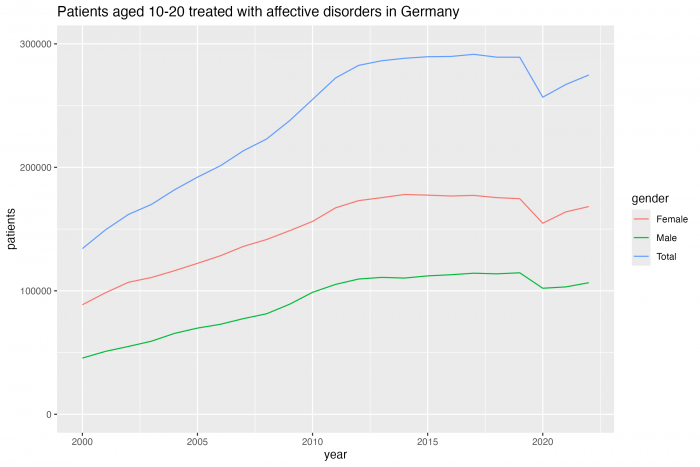
And, indeed, this shows a strong (long-going) increase for days for which young people in Germany are treated with affective disorders (i.e., meta-category for various forms of depression). Which is concerning.
Then again, increases in depression might simply reflect a reduction in stigma and increased willingness to look for help. So let’s have a look at suicide rates, for which this argument does not hold.
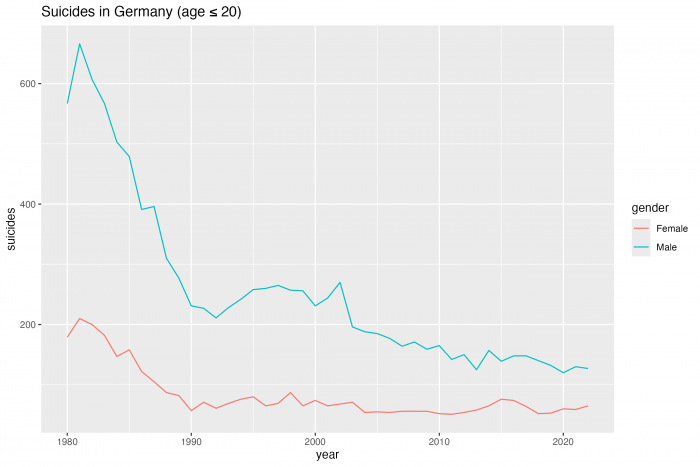
Here, at least for Germany, we don’t find an increase. The opposite, it’s actually quite the success story.
I was also able to get data for Europe, showing suicides for 15-20 year olds. Looks quite similar.
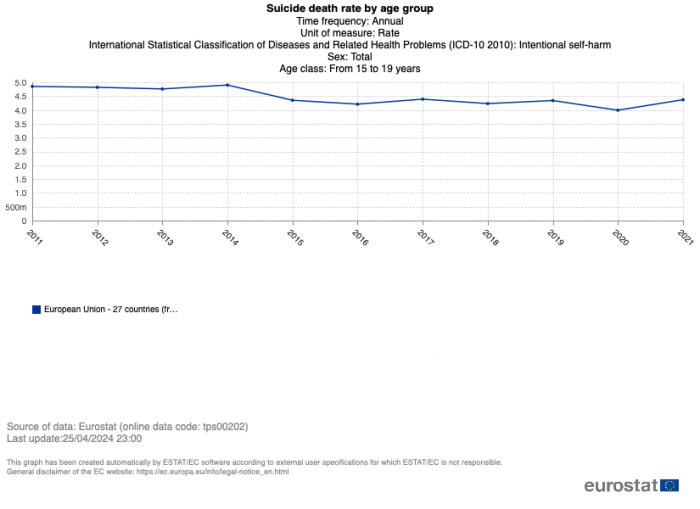
Finally, the World Happiness Report finds that worldwide life satisfaction is actually increasing.
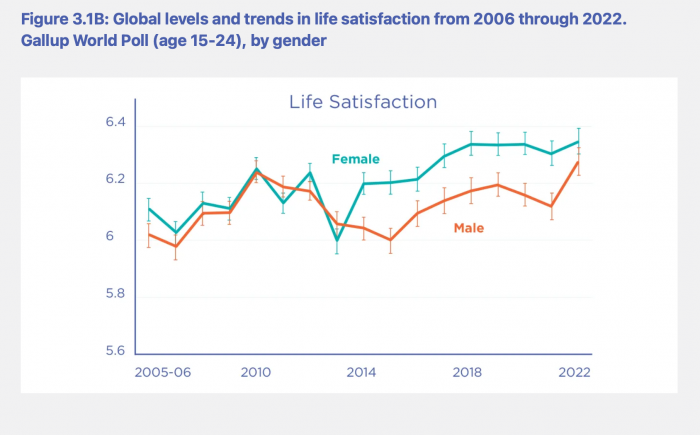
So what do make of that? Yes, there might be a negative development regarding mental health in the U.S., and perhaps also the Anglosphere. And indeed, also the World Happiness reports declining levels of life satisfaction in the U.S.
However, this is not a global trend.
Although Haidt sometimes mentions in writing that these trends don’t necessarily generalizes, there’s not a single graph demonstrating these global trends. Reading the book gives you a false impression regarding the general development of adolescents globally.
What’s the effect of social media use on well-being?
I could write an entire book on the effects of social media use on well-being, so let’s try to keep it brief. First, most literature overviews look at social media in general, not focused on young people, reporting relations not causal effects. These general overviews report neutral or small negative relations between social media use and mental health.
Granted, the pictures differs somewhat depending on type of social media use or outcome. Different uses of social media have different relations with well-being. And it’s increasingly confirmed that the effects also differ among adolescents, with some benefitting from social media use and others not.
However, and let me stress this, here nuance can be misleading. In the end, we want to find out if using social media is on average and in sum bad for adolescents. It might be the case that exchanging personal messages via Instachat is beneficial, but if that’s only 5% of your activity it doesn’t matter. Or it wouldn’t matter if 20% benefit, when 50% show negative effects.
Unfortunately, we are still missing high quality, international, large scale studies on the causal effects of adolescent social media use on mental health. I could cherry-pick some individual studies, but I’m not sure if that’s really helpful. So the empirical basis for answering this question is weak.
If we look at literature overviews, there exists some research that has analyzed adolescents social media use specifically. In their great meta-meta analysis, Meier & Reinecke list the following overviews.
(Table can be found in their online appendix. Note that these are (predominantly/exclusively?) on between person relations, not actual effects. Hence, again all caveats apply re. causality.)
| Author(s) | Year | Publications included | Type of studies | CMC concept(s) | MH concept(s) | Conclusion |
| Best et al. | 2014 | 43 | QN & QL | SM use (various) | Varous (self-esteem, social support, social capital, social isolation, depression) | Mixed, conditional |
| Keles et al. | 2019 | 13 | QN | SM use (various) | Depression, Anxiety, distress | Negative; conditional positive |
| McCrae et al. | 2017 | 11 | QN | SM use (various) | Depression | Negative, conditional |
| Sarmiento et al. | 2018 | 68 | QN | SM use (various) | Anxiety, depression, loneliness | Negative, conditional |
| Shapiro & Margolin | 2014 | 27 | QN | SNS use (various) | Various (connectedness, self-esteem) | Mixed, conditional |
| Wu et al. | 2016 | 12 | QN | Internet & SM use (various) | Various (connectedness, loneliness, social isolation, depression, anxiety) | Mixed |
What’s their result? Overall, studies either find mixed or conditionally negative relations.
This is aligned with Niklas Johannes and my own (unsystematic, narrative) literature overview on the impact of digital technology (so not just social media) on adolescent well-being, where we conclude that “Overall, findings imply that the general effects are on the negative end of the spectrum but very small.”
So yes, most findings nowadays seem to converge on the position that social media effects are likely negative. There’s much more uncertainty regarding how negative exactly, and what that means practically.
Negative but irrelevant? Negative and relevant? Negative and highly relevant? Haidt argues for the latter, when most scholars would likely assume one of the former.
Is offline childhood over-regulated?
What many reviews forget is that Haidt says there are two aspects causing the mental health crisis. The second one, which gets much less public attention, is that young people are over-regulated offline. Adults are everywhere, there’s little free play, there are no risks.
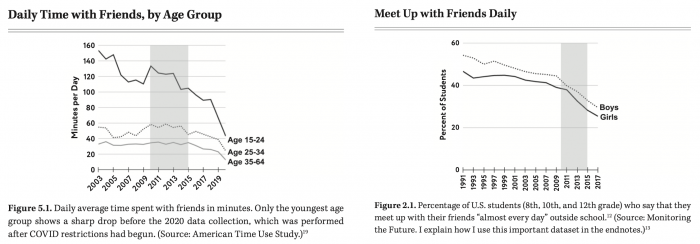
Let me share an anecdote with you. I once had the privilege to spent three months in beautiful Santa Barbara, California. Two months I lived together with a great family of five, and we had a splendid time. However, there was this one thing that perplexed me.
The three kids, I think somewhere between 4 and 8 years of age, weren’t allowed to leave the house and play outside. They weren’t even allowed to play unsupervised in the front yard.
It remember the words in my head: It’s too dangerous, there are kidnappers, stay inside. And you can imagine that three energetic kids inside the house can be challenging.
I did not understand this: Why swap an admittedly severe but unfathomably unlikely harm (Santa Barbara, after all) with the at least moderate but I’d say guaranteed harm of keeping kids inside and supervised all the time?
That’s only an anecdote. But basically it’s the same observation Haidt is making on a larger scale. And it’s nothing I’ve ever heard of or experienced in Europe. I don’t have the expertise to comment on whether or not the literature backs Haidt’s claim here. It seems plausible, yet I don’t know. But I think his theoretical arguments for free range kids and unsupervised play are entirely convincing. I buy into his kids being antifragile argument. Just like a tree needs wind to strengthen its trunk, kids benefit from exposure to moderate risks in order to grow, to develop resilience, to experience life.
The important thing to stress is that Haidt says that both aspects (social media plus over-regulated offline life) are the reasons behind the decline in well-being. But while I’m sold on the second line of reasoning, I don’t have the necessary expertise to comment on its veracity. However, if it were true, it might actually be the better explanation behind the negative mental health trend mainly observed in the U.S..
Depressed kids or over-concerned boomers?
After this review of The Anxious Generation, what’s my verdict? On a theoretical level, I think many of his arguments are plausible and convincing. Especially that overuse is critical, that harms are particularly due to opportunity costs (social media as experience blockers, replacing on average better behavioral alternatives), that free play and unmediated social time need to be reestablished. I don’t see the book as critical as some of my colleagues, and I think it would be too easy to simply discard Haidt’s criticism.
Not being able to show something empirically does not necessarily mean it doesn’t exist practically (Duheme-Quine problem). Although the empirical literature does not support his negative reading of the effects, the empirical literature is also often of low quality. If our approach is subpar we generally (but not necessarily) underestimate effects. Measuring and correctly analyzing media effects is really really hard, it require large scale ressource that are currently still missing.
Although the mental health crisis isn’t global, it’s not absurd to entertain the thought that the U.S. might be our canaries in the coal-mine. The U.S. is a cultural giant, they developed social media after all, and with so many others things it could be that other countries will follow suit.
During the last couple of years, in light of new evidence I have increasingly shifted my perspectives from social media effects being slightly positive, to neutral, to slightly negative. The book made me wonder if I shouldn’t change that to just negative.
In preparing for this post, reading responses to the book, seeing recent stats, and eyeballing the latest publications, I have come to the conclusion that, no, I don’t have to adjust my prior.
Yes, Haidt does have a point. However, Haidt is exaggerating the case. Both in terms of the mental health crisis, which is largely limited to the U.S., and even there potentially not as strong as assumed, and in terms of media effects, which indeed are likely in the negative spectrum, but not as negative as presented.
Yes, Haidt is over-concerned. However, it’d still be wise to remain critical regarding social media use (and especially overuse). Yes, some parts of young people in the Anglosphere might be anxious, which is troubling, but not an entire generation worldwide. Still, let’s keep a close look at those stats.
Until then, no need to be overly concerned that this time it’s finally different, or that this time the kids won’t be alright.
(Updated: 2024-05-22)
